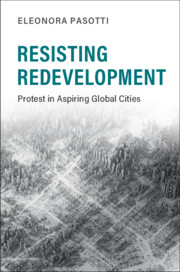Book contents
- Resisting Redevelopment
- Cambridge Studies in Contentious Politics
- Resisting Redevelopment
- Copyright page
- Dedication
- Contents
- Illustrations
- Acknowledgments
- Part I Setting the Comparison
- Part II Explaining Mobilization
- 5 Experiential Tools and Networks
- 6 Squatting, Experiential Tools, and Protest Legacies
- 7 Judicial Resistance, Experiential Tools, and Protest Legacies
- 8 Protest with High Union Support
- Part III Explaining Impact
- Book part
- Bibliography
- Index
- Cambridge Studies in Contentious Politics
8 - Protest with High Union Support
Buenos Aires
from Part II - Explaining Mobilization
Published online by Cambridge University Press: 09 March 2020
- Resisting Redevelopment
- Cambridge Studies in Contentious Politics
- Resisting Redevelopment
- Copyright page
- Dedication
- Contents
- Illustrations
- Acknowledgments
- Part I Setting the Comparison
- Part II Explaining Mobilization
- 5 Experiential Tools and Networks
- 6 Squatting, Experiential Tools, and Protest Legacies
- 7 Judicial Resistance, Experiential Tools, and Protest Legacies
- 8 Protest with High Union Support
- Part III Explaining Impact
- Book part
- Bibliography
- Index
- Cambridge Studies in Contentious Politics
Summary
Chapter 8 examines mobilization in three cases in Buenos Aires, where union support is strong. It also shows that when unions failed to support a neighborhood organization, residents shifted their strategy to experiential tools instead. The first two of the anti-displacement groups examined – the Movimiento de Ocupantes e Inquilinos Movement of Renters and Occupiers (MOI) and the Asamblea del Pueblo San Telmo – actually constitute official chapters in the national union, Central de Trabajadores de la Argentina (CTA). That link provided renters and squatters with exceptional organizational and mobilization resources. Despite this common linkage, the two organizations differed strategically. The MOI engaged in direct actions, rallies, occupations, and, above all, in extensive technocratic negotiations with authorities over Law 341 and its implementation. The Asamblea del Pueblo San Telmo, instead, focused on occupations and direct actions and pursued a strategy of subversive resistance, consciously serving a marginal population in order to discourage gentrification. In contrast, the Asamblea Parque Lezama lacked close institutional and political affiliation to unions, and, rather than resorting to militancy, it succeeded with experiential tools.
Keywords
- Type
- Chapter
- Information
- Resisting RedevelopmentProtest in Aspiring Global Cities, pp. 210 - 234Publisher: Cambridge University PressPrint publication year: 2020

